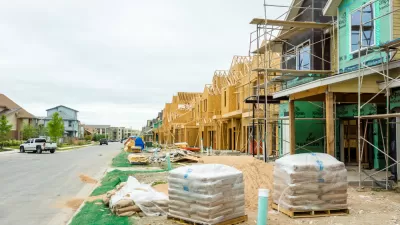The U.S. remains largely a suburban nation, though central cities are experiencing a great comeback after years of population loss. But what exactly is a suburb? A new report from the Urban Land Institute provides answers by providing subcategories.

"The report, Housing in the Evolving American Suburb [PDF], provides a new analytic framework developed by RCLCO [Real Estate Advisors] for the ULI Terwilliger Center for Housing that describes different kinds of suburbs based on the key factors that define and determine their housing markets," writes Robert Krueger in a press release for ULI.
The report classifies and compares suburbs in the 50 largest metro areas in the U.S. – shown in a searchable online map – and assesses the key issues that will shape suburban residential demand and development in the years ahead.
Krueger list seven bullets that show the dominance of suburbs over central cities in terms of population, employment, and other demographics. Two exceptions:
- Between 2005 and 2010, employment in suburban areas remained stagnant, while it increased by 8.2 percent in urban areas. But between 2010 and 2014, jobs increased by 9 percent in suburbs versus 6 percent in urban areas.
- The regional variation in home values between suburbs and cities is substantial. On average, the median home value in urban areas is $365,000 compared to $305,000 in suburban areas.
Among suburbs, the report considers three categories:
- High-density suburban: relatively dense outer neighborhoods and commercial corridors.
- Suburban: well-populated neighborhoods where most of the housing stock consists of single-family detached homes.
- Low-density suburban: neighborhoods where most of the housing stock consists of single-family detached homes, and where there is some undeveloped land.
One disturbing characteristic they all share: "Auto dependence is uniformly high across all types of suburbs, even in those with better access to transit."
The report further differentiates suburbs into "five suburban paradigms" ranging from "established high-end suburbs" to "greenfield value suburbs." See page 5 of report [PDF] for their definitions.
Laura Kusisto of The Wall Street Journal was the first to report on the analysis. The "research shows that suburbs are continuing to outstrip downtowns in overall population growth, diversity and even younger residents," writes Kusisto (also see short summary of the article, fully accessible on Builder).
The Journal's '"binary classification" prompted Joe Cortright to review her article for City Observatory:
Last Friday’s Wall Street Journal came out with another eye-catching headline story in the city versus suburbs battle of the bands: “Suburbs outstrip cities in population growth, study finds."
On its face, the article seems to imply that much of what has been written in recent years about a rebound in cities is either wrong or somehow overstated.
Cortright suggests to his readers that they read the ULI press release to understand how their report is not an urban vs. suburban analysis, but a suburb vs. suburb analysis. In addition to Krueger's press release, see a short review of the report by
Hat tip to Tom Rubin via Sierra Club Bay Area Transportation Forum.

Planetizen Federal Action Tracker
A weekly monitor of how Trump’s orders and actions are impacting planners and planning in America.

Congressman Proposes Bill to Rename DC Metro “Trump Train”
The Make Autorail Great Again Act would withhold federal funding to the system until the Washington Metropolitan Area Transit Authority (WMATA), rebrands as the Washington Metropolitan Authority for Greater Access (WMAGA).

The Simple Legislative Tool Transforming Vacant Downtowns
In California, Michigan and Georgia, an easy win is bringing dollars — and delight — back to city centers.

The States Losing Rural Delivery Rooms at an Alarming Pace
In some states, as few as 9% of rural hospitals still deliver babies. As a result, rising pre-term births, no adequate pre-term care and "harrowing" close calls are a growing reality.

The Small South Asian Republic Going all in on EVs
Thanks to one simple policy change less than five years ago, 65% of new cars in this Himalayan country are now electric.

DC Backpedals on Bike Lane Protection, Swaps Barriers for Paint
Citing aesthetic concerns, the city is removing the concrete barriers and flexposts that once separated Arizona Avenue cyclists from motor vehicles.
Urban Design for Planners 1: Software Tools
This six-course series explores essential urban design concepts using open source software and equips planners with the tools they need to participate fully in the urban design process.
Planning for Universal Design
Learn the tools for implementing Universal Design in planning regulations.
Smith Gee Studio
City of Charlotte
City of Camden Redevelopment Agency
City of Astoria
Transportation Research & Education Center (TREC) at Portland State University
US High Speed Rail Association
City of Camden Redevelopment Agency
Municipality of Princeton (NJ)




























